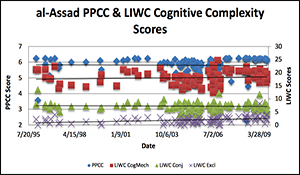Leader Assessment of Bashar al-Assad (Part II)


A Multi-disciplinary, Multi-method Approach to Leader Assessment at a Distance: The Case of Bashar al-Assad (Part II: Analytic Approaches).
Author | Editor: Kuznar, L. (NSI, Inc) & Suedfeld, P. et al. (University of British Columbia).
This report suggests potential types of actions and messages most likely to influence and deter Bashar al-Assad from using force in the ongoing Syrian civil war. This study is based on multidisciplinary analyses of Bashar al-Assad’s speeches, and how he reacts to real events and verbal messages from external sources.
The results are summarized in a two-part report. Part I provides a summary, comparison of results, and recommendations. Part II (this document) describes each analytical approach in detail.
Data: The speeches used in the study were delivered by al-Assad from Jan 2000 to Sept 2013; the past six years was sampled most densely. Additional Twitter feeds were analyzed to gauge his influence in the region.
Analytical Approaches: Five separate methods were used to analyze the speeches:
- Approach 1: Integrative Complexity (IC) analysis as developed by Dr. Peter Suedfeld (University of British Columbia) is a measure of the degree to which a source recognizes more than one aspect of an issue or more than one legitimate viewpoint on it (differentiation), and recognizes relationships among those aspects or viewpoints (integration).
- Approach 2: Thematic Discourse Analysis based on methodologies developed by National Security Innovations, Inc. (NSI) and conducted by Indiana University – Purdue University, Fort Wayne (IPFW). It provides general predictions of which themes will precede conflict and which will emerge as a reaction to conflict, an assessment of the major narratives al-Assad draws on to persuade his audiences, and analyses of themes that emerge around specific events.
- Approach 3: Automated Leadership Trait Analysis using ProfilerPlus and the Language Inventory and Word Count (LIWC) software (JHU-APL). The primary objectives were to examine (1) the cognitive complexity through means independent from the UBC method in Approach 1; and (2) al-Assad’s leadership traits using Hermann’s (2002) method of political profiling. Selections of English translations of al-Assad’s speeches were analyzed using two pieces of software: ProfilerPlus; and Linguistic Inquiry and Word Count (LIWC). Automated text analyses ingest and analyze the whole speech not simply randomly selected sections.
- Approach 4: Geopolitical Discourse Development Analysis. CSIS (Center for Strategic and International Studies) analyzed the common corpus of 124 speeches by Bashir al-Assad from 2000 to present. They provided qualitative interpretations of major themes that emerged in al-Assad’s discourse over the course of the 13-year period studied
- Approach 5: Analysis of Influential Arab Twitter Feeds. A team of analysts from Texas A&M University analyzed the twitter feeds of 195 influential Arabs in the Middle East, in each 24 hour period before and after al-Assad delivered a speech for the months of August and September, 2013. They also examined the relative influence of al-Assad and other regional players in the Arabic Twittersphere to determine the extent the regime is able to influence public opinion.
Major Findings: The major findings of these studies include:
- al-Assad is capable of recognizing other viewpoints and evaluates them in a nuanced and context-dependent manner
- al-Assad values logical argumentation and empirical evidence al-Assad’s integrative complexity is relatively high, but might be lower before he takes decisive action or when under intense threat
- al-Assad’s reasoning is consistent with his Arab nationalist Ba’athist political ideology, and with a consistent opposition to Israel and Western domination; al- Assad sees Arab resistance and his leadership, or at least that of the Ba’ath party, as essential.
Key Recommendations: We used the doctrinal 7-Step MISO process to characterize al-Assad as a target audience of one, and we absorbed the relevant components of our multi- method analyses into the Target Audience Analysis format. The main practical recommendations are:
- Avoid direct threats to the Syrian Ba’athist regime’s hold on power;
- Appeal to al-Assad’s relatively high baseline level of Cognitive Complexity (ability to see different sides of an issue, flexible decision-making, openness to information), pragmatism, and respect for Arab nationalism to broker a negotiated settlement; and
- Identify and exploit al-Assad’s dynamic levels of Integrative Complexity to assess his relative susceptibility, develop arguments and recommended psychological actions and/or refine assessment criteria at a specific point in time.
Main Findings
Basic findings from studies of al-Assad’s speeches, 2000 – 2013
- Various Measures of Cognitive Complexity: Multiple measures converge to show that al-Assad is capable of appreciating different viewpoints and the nuances between them. al-Assad’s baseline integrative complexity (his ability to differentiate different perspectives and integrate them) is relatively high compared to other leaders in the region. al-Assad furthermore demonstrates an ability to be logically consistent in how he evaluates situations, and is responsive to credible (in his view) empirical evidence.
- Deterrence: Traditional deterrence theory should apply to al-Assad generally, although during periods of intense stress he may deviate more from such a model.
- Integrative Complexity (IC): In general his IC has not changed over the course of the conflict. But analysis of specific events suggests his IC tends to be lower when he is under intense threat, or before taking decisive and violent action, compared to afterwards.
- Arab Nationalism: al-Assad wants to lead Arab interests; he is a staunch Arab nationalist.
- Opposition to the West and Israel: al-Assad wishes to oppose Western and Israeli influence in the Arab world; the history of Middle Eastern peace talks makes al- Assad cynical about Israel-Palestine negotiations, despite his cognitive inclination for negotiation.
- Secular Ba’athist Political Ideology: al-Assad’s reasoning and values are consistent with a more secular, Ba’athist, political ideology.
Main Recommendations:
We used the doctrinal 7-Step MISO process to characterize al-Assad as a target audience of one, and we absorbed the relevant components of our multi-method analyses into the Target Audience Analysis format. The main practical recommendations are:
- Avoid direct threats to the Syrian Ba’athist regime’s hold on power;
- Appeal to al-Assad’s relatively high baseline level of Cognitive Complexity (ability to see different sides of an issue, flexible decision-making, openness to information), pragmatism, and respect for Arab nationalism to broker a negotiated settlement; and
- Identify and exploit al-Assad’s dynamic levels of Integrative Complexity to assess his relative susceptibility, develop arguments and recommended psychological actions and/or refine assessment criteria at a specific point in time.

